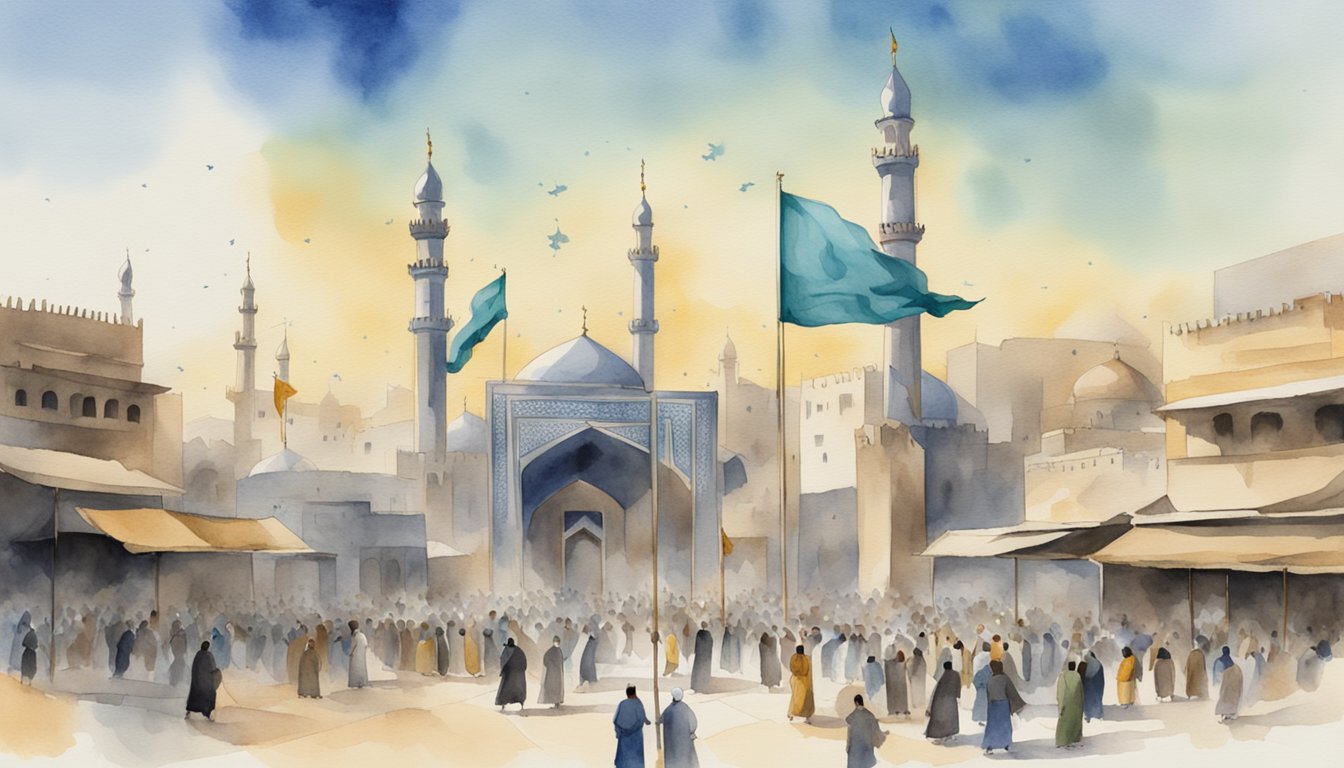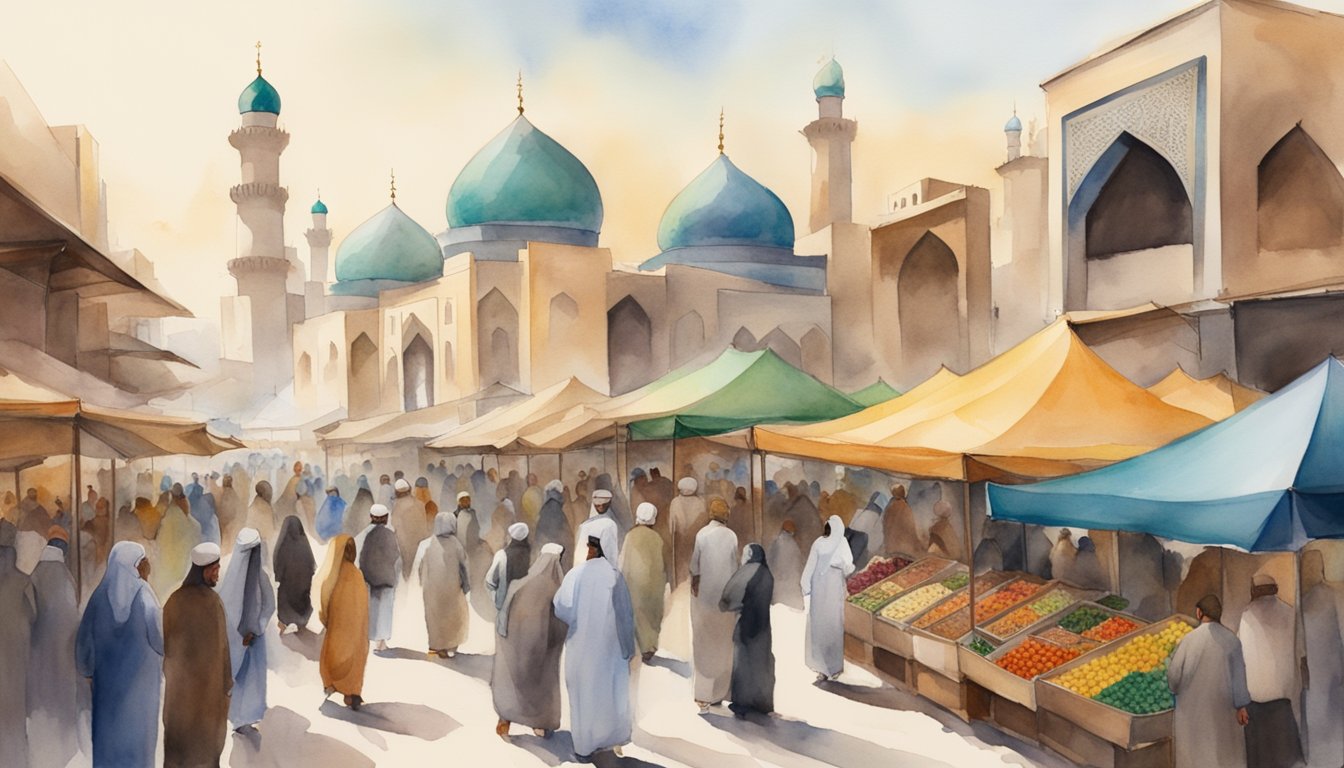Overview of Sunni and Shia Islam
Sunni and Shia Islam are the two main branches of the Islamic faith, each with unique traditions and beliefs stemming from a historical split. Their distinctions influence not just the spiritual realm but also have strong sociopolitical implications.
Historical Schism and Key Differences
The division between Sunni and Shia Muslims originated from a dispute over who should succeed the Prophet Muhammad as the leader of the Islamic community after his death in 632 CE. Sunnis believed that the new leader should be elected from those capable of the job, and they supported Abu Bakr, a close friend and advisor of Muhammad. On the other hand, Shias held that leadership should stay within the Prophet’s family, backing Muhammad’s cousin and son-in-law, Ali.
The names themselves are illustrative of their stances: Sunni comes from “Ahl as-Sunnah,” meaning people of the tradition of Muhammad, while Shia is short for “Shiat Ali,” meaning partisans of Ali. The schism deepened over the years, evolving into differing beliefs about religious authority and practices — Sunnis emphasize the authority of written traditions (Hadiths) and consensus among Islamic scholars (Ulama), whereas Shias focus more on the divine guidance of their Imams, whom they consider to be Muhammad’s spiritual heirs.
Major Beliefs and Practices
While both Sunnis and Shias share most of the fundamental aspects of Islamic belief — such as the Five Pillars of Islam — their practices and interpretations can vary. Sunnis form the majority in Islam and often look to the actions (Sunna) of Muhammad for guidance, as recorded in the Hadiths. Shi’as, meanwhile, place significant religious authority in the lineage of Imams, starting with Ali; they believe these Imams are infallible and divinely appointed.
Particularly, Shias observe the commemoration of Ashura, the day of mourning for the martyrdom of Hussein, the grandson of Muhammad and the third Shia Imam, at the Battle of Karbala. Sunnis also recognize Ashura but give it less emphasis and observe it as a day of fasting, reflecting a day of salvation for previous prophets.
Geographical Distribution and Demographics
Sunni Islam is the larger sect globally, with an estimated 85-90% of the world’s Muslim population. They are the majority in most of the Muslim world, including countries like Egypt, Saudi Arabia, and Turkey. Shia Muslims, comprising about 10-15% of all Muslims, predominantly reside in Iran, Iraq, Bahrain, and Azerbaijan, with significant communities in Lebanon, Yemen, and other parts of the Middle East.
Demographically, the variance in population between Sunnis and Shias has shaped not just religious but also political landscapes in these regions, leading to alliances and conflicts that are key to understanding the geopolitics of the Middle East today. The cities of Mecca and Medina hold profound importance in Sunni Islam, while places like Najaf and Karbala are holy to Shias.
Notable Historical and Contemporary Conflicts

The Sunni-Shia divide has reverberated through Islamic history, sparking confrontations that have shaped political landscapes and incited sectarian violence. From the early caliphate’s discord to modern geopolitical strife, these conflicts carry profound implications for the Muslim world and beyond.
Early Islamic Disputes and Civil Wars
The schism between Sunni and Shia Muslims originated from a deep-rooted historical controversy over the rightful successor to Prophet Muhammad. It ignited the first major civil wars in Islam, such as the Battle of Siffin in 657 AD between Caliph Ali (cousin and son-in-law of Muhammad) and the Governor of Syria, Muawiyah. This period was further marked by the tragic event of Karbala in 680 AD, where Hussein ibn Ali, a significant Shia figure, was killed, solidifying the divide.
Impact of Colonialism and Modern State Formation
Centuries later, the collapse of the Ottoman Empire and the subsequent drawing of new national borders by colonial powers exacerbated Sunni-Shia tensions. Colonialism interfered with the organic development of these communities, often favoring one group over the other, leading to imbalances in countries like Iraq and Lebanon. During the 20th century, as countries like Iran and Iraq formed modern states, political leadership either marginalized Shia communities or, as with the Islamic Revolution in Iran (1979), a Shia theocracy emerged.
Current Sectarian Tensions and Conflicts
Today, sectarian violence continues to disrupt the Islamic world, notably in Syria, Iraq, Yemen, and Bahrain. In Syria, the conflict morphed from an anti-government uprising into a regional proxy war involving Sunni-majority countries like Saudi Arabia backing opposition groups, while Shia-majority Iran supports President Bashar al-Assad. Iraq has witnessed sectarian violence, notably with the emergence of the Islamic State, exacerbating Sunni-Shia tensions. Yemen‘s ongoing civil war involves a Sunni-dominated government against Iranian-backed Shia militias, while in Bahrain, the Shia majority has often clashed with the Sunni monarchy.
Each of these confrontations tells a detailed story of the intricate web that Sunni and Shia dynamics weave across the Middle East, affecting lives and reshaping nations.
Cultural Contributions and Community Life

The rich tapestry of Islamic civilization is woven with the cultural contributions of both Sunni and Shia communities. These branches share a plethora of traditions and regard the Quran as their holy text. However, the interpretation of hadiths, sayings and actions of the Prophet Muhammad, often differs, adding to the diverse Islamic cultural mosaic.
Sunni Muslims, representing the majority, are known for their “six authentic books” of hadith. Their religious life is guided by these texts, alongside the Quran, shaping a community bonded by shared spiritual practices and theology. Celebrations like Eid al-Fitr and Eid al-Adha showcase unity and generosity, essential elements of the Muslim community life.
Meanwhile, the Shia Muslims add further layers to Islamic culture, particularly through their remembrance of Muharram. This includes the deeply spiritual Ashura, commemorating the martyrdom of Hussein ibn Ali. It’s a potent fusion of grief, passion, and the enduring call for social justice. The Shia tradition enriches Muslim artistic expression with poignant poetry and stirring passion plays.
Leaders, or *Imams, in Shia Islam, hold a special doctrinal place as those appointed by divine order. Their leadership extends beyond mere governance, profoundly influencing cultural and communal norms. Islam’s theological diversity is thus mirrored and celebrated through varied cultural expressions in architecture, music, and literature, echoing the teachings revered in their respective communities.
For a glimpse into how these communities interact, the study of interculturality between Shia and Sunni Muslims in Iran offers insight into increased cultural sensitivity and identity (Religious affiliation and intercultural sensitivity).
Both sects contribute significantly to a mosaic of rituals and celebration in Islamic culture, enhancing community solidarity and preserving their rich heritage across generations.

